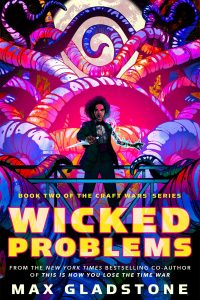Paul Kincaid Reviews The Big Book of Cyberpunk edited by Jared Shurin
 The Big Book of Cyberpunk, Jared Shurin, ed. (Vintage 978-0-59346-723-7, $32.50, 1,136pp, tp) September 2023.
The Big Book of Cyberpunk, Jared Shurin, ed. (Vintage 978-0-59346-723-7, $32.50, 1,136pp, tp) September 2023.
In the immediate aftermath of the Second World War, the pre-War experiment of television was reintroduced. For a time, there was unease that the abyssal screen into which we stared might also be staring into us – “Big Brother is watching you” as George Orwell put it. Events such as the coronation of Queen Elizabeth in 1953 led to a massive uptake in televisions, and the box in the corner of the room almost instantly became domesticated and accepted. Yet the unease never quite went away, and 20-odd years later, when new screens started to appear, first on office desks then in the home, that unease reasserted itself. In the story that gave its name to the new branch of fiction fuelled by this tension, “Cyberpunk”, Bruce Bethke tips his hat to that TV moment when the older generation still thought “a computer has got to be a brain in a single box.” Like so many other literary movements, cyberpunk was a product of that moment of doubt when you don’t know what the new thing really is.
Of course, any origin story is always wrong. Cyberpunk did not begin with Bethke’s 1983 story. One way of looking at it would start a year earlier with a Disney film, Tron, which used novel computer-generated imagery to take the viewer into the garish interior of a computer game. While another film, Blade Runner, employed nonefirst of the narrative devices of what would become cyberpunk, it did present a cityscape filled with screens, and in so doing created an aesthetic for the nascent subgenre. Although it plays no part in the vision of cyberpunk laid out here by Shurin, cyberpunk has ever since been at least partly an aesthetic movement. Little wonder that the original and, to a degree, definitive anthology was titled Mirrorshades, although by the time that anthology appeared in 1986 there was a sense that the movement had already run its course. Shurin includes a story from Mirrorshades, “Petra” by Greg Bear, and pointedly and correctly identifies it as not cyberpunk. The nature of the subgenre was debatable almost from its inception, and by the end of the decade Bruce Sterling, the editor of Mirrorshades, was loudly asserting that cyberpunk was dead.
Jared Shurin would disagree. He’s not the only one: in terms of computer games and manga, for instance, cyberpunk seems to be more current and more relevant than ever. In terms of prose the evidence before us is this massive volume, and the evidence is, to say the least, questionable. Across something over 1,100 large, double-columned pages, Shurin has amassed 108 stories by 107 authors (Bruce Sterling and Paul Di Filippo both appear in collaboration and separately; there’s a collaboration between Janelle Monáe and Alaya Dawn Johnson; and William Gibson appears on his own and in collaboration with Michael Swanwick). The earliest of the stories is “Coming Attraction” by Fritz Leiber from 1950, the most recent are a handful of stories from 2022. In other words, this all-embracing account of cyberpunk begins long before the subgenre was born, and carries on long after it had, by some accounts, died.
The question, therefore, is how a form of fiction that flared so briefly and so locally (even British writers who attempted cyberpunk in the 1980s came across as pale imitations) has spawned a collection that covers over 70 years and brings in stories from across the globe. The answer, one of the answers, is the particularly generous definition of cyberpunk offered by Shurin who insists that it is “literature about change,” or more precisely, it is “speculative fiction about the influence of technology on the scale, the pace, or the pattern of human affairs.” I can’t help thinking that practically all of science fiction falls within that remit. There are, for instance, stories here like the excellent “Alligator Heap” by E.J. Swift or “Glitterati” by Oliver K. Langmead that portray an effete rich living high above a desperate poor. They fall strictly within Shurin’s definition, and yet apart from more up-to-date technological references they seem to owe more to “A Story of the Days to Come” by H.G. Wells or Metropolis by Fritz Lang than they do to anything we might label cyberpunk. Indeed, Shurin’s practice of including a precursor story at the beginning of each section (James Tiptree Jr’s “The Girl Who Was Plugged In” leads off “Self”; Samuel R. Delany’s “Time Considered as a Helix of Semi-Precious Stones” leads off “Society”; and so on) tends to suggest that cyberpunk is not a radical break in the practice of science fiction, but rather a seamless continuation.
Within each of these sections (along with “Self” and “Society”, there’s “Culture”, “Challenge”, and finally “Post-Cyberpunk”, though the majority of the stories, even in that last section, could easily be included in multiple others) the stories are arranged in roughly chronological order. It’s a logical arrangement, thought there are perhaps unexpected consequences. To read Pat Cadigan’s “Pretty Boy Crossover” immediately after “The Girl Who Was Plugged In” rather than more than a decade apart, is to note how much in terms of language, setting, even cultural references the two stories share. And similar echoes recur throughout the volume. For instance, “I Can Transform You” by Maurice Broaddus, a rather satisfying crime story set at the interface between smooth corporations and rough street toughs, but with extra added aliens, is followed just a few pages later by “Keeping Up With Mr Johnson” by Steven S. Long, which describes pretty much the same situation, but this time with elves and orcs and magic spells. There are further variations on this theme throughout the book, though in truth it is not easy to see how either of these instances fall within the cyberpunk remit.
The most persistent motifs throughout the book are petty crime (far too many examples to list), or machines trying to become human (the best of many examples is perhaps “The Endless” by Saad Z. Hossain, though Shurin’s classification shunts this into the post-cyberpunk category), or humans trying to become machines. Again, there are too many examples of this last type, but typical might be “Gray Noise” by Pepe Rojo (translated by Andrea Bell) in which the central character has a camera implanted in his eye, which is immediately followed by “Retrocity” by Steve Beard, in which the central character has a camera synched to him. One gets the impression that in cyberpunk we can’t take anything in unless it is viewed through a lens. Even so, I can’t help feeling that D.G. Compton did the same thing with more emotional resonance at least a decade before there was such a thing as cyberpunk.
Such examples at least tend to revolve around the interplay of the human and the technological, but much else relegates technology to the background, in much the same way that mobile phones and algorithms are part of the background of all our lives. John Kessel’s “The Last American” is a superb account of the collapse of America under a right-wing dictatorship, while Ken MacLeod’s “Earth Hour” dramatizes the politicking around a massive bioengineering project, and “The Memory Librarian” by Janelle Monáe & Alaya Dawn Johnson describes the human and sexual consequences of a society in which memories are stored and controlled. Technology is there, not as the focus of the story but simply to provide the atmosphere through which the story moves. What is noticeable in this collection is the shift over time from the portrayal of government in early cyberpunk as a branch of business, the corporation, to later stories such as “The State Machine” by Yudhanjaya Wijeratne and “The Tin Pilot” by K.A. Teryna (translated by Alex Shvartsman), in both of which power is the preserve of something simply called The Machine. This is rule by algorithm: “The Machine doesn’t make mistakes” we are assured; but we’ve been told that before. These, and so many others like them, have absorbed the devices and the look of cyberpunk, but that doesn’t mean that they are cyberpunk. In a very perceptive remark in his introduction to the “Post-Cyberpunk” section, Shurin notes that cyberpunk “has gone from software to operating system,” and I can’t help feeling that when the obsessions of cyberpunk (the human-digital interface, for instance) stop being the subject of the story and become the background against which the story is played out, that is the point at which cyberpunk is absorbed indistinguishably into the general milieu of science fiction. That feels to be the case with anything up to 75% of the stories gathered here.
What is highlighted by the chronological structure of the book is that where cyberpunk began as a distinctly American form that didn’t spread effectively to other Anglophone science fictions. After its apparent demise in the US it went on to find a home in non-Anglophone cultures, for example in “Violation of the TrueNet Security Act” by Taiyo Fujii (translated by Jim Hubbert), and elsewhere. A majority of the more recent contributions to this volume are by nonwhite, nonmale, or nonstraight authors (although Shurin seems to explicitly exclude Afrofuturism from consideration as a successor form to cyberpunk in his introduction). It is as if the spread of cyberpunk acts as a measure of the way technological change differently affects social change among different social and cultural groupings around the world.
The Big Book of Cyberpunk is most certainly big, and it is undoubtedly a book. As an anthology of short science fiction stories it is excellent, there’s a high percentage of first rate fiction here. But cyberpunk? That is, perhaps, open to question.
Paul Kincaid has published two collections of essays and reviews, What It Is We Do When We Read Science Fiction (2008) and Call and Response (2014). His most recent book is Iain M. Banks (2017). He has been awarded the Clareson Award from the SFRA and the BSFA Non-Fiction Award.
This review and more like it in the October 2023 issue of Locus.
 While you are here, please take a moment to support Locus with a one-time or recurring donation. We rely on reader donations to keep the magazine and site going, and would like to keep the site paywall free, but WE NEED YOUR FINANCIAL SUPPORT to continue quality coverage of the science fiction and fantasy field.
While you are here, please take a moment to support Locus with a one-time or recurring donation. We rely on reader donations to keep the magazine and site going, and would like to keep the site paywall free, but WE NEED YOUR FINANCIAL SUPPORT to continue quality coverage of the science fiction and fantasy field.
©Locus Magazine. Copyrighted material may not be republished without permission of LSFF.







